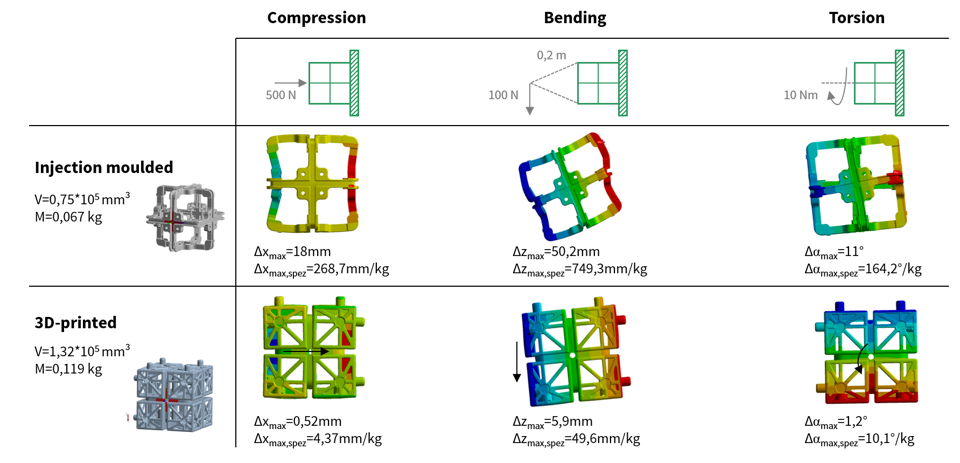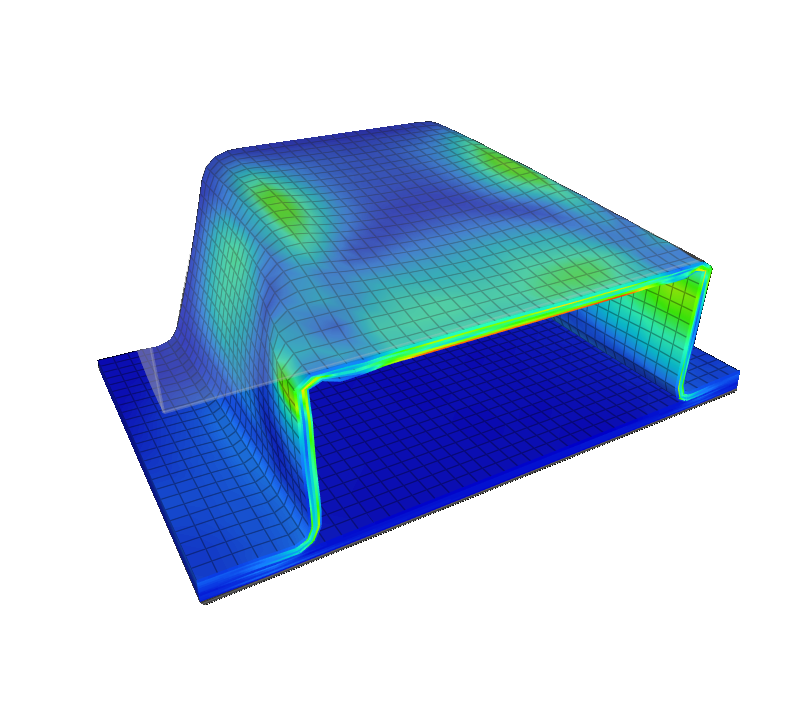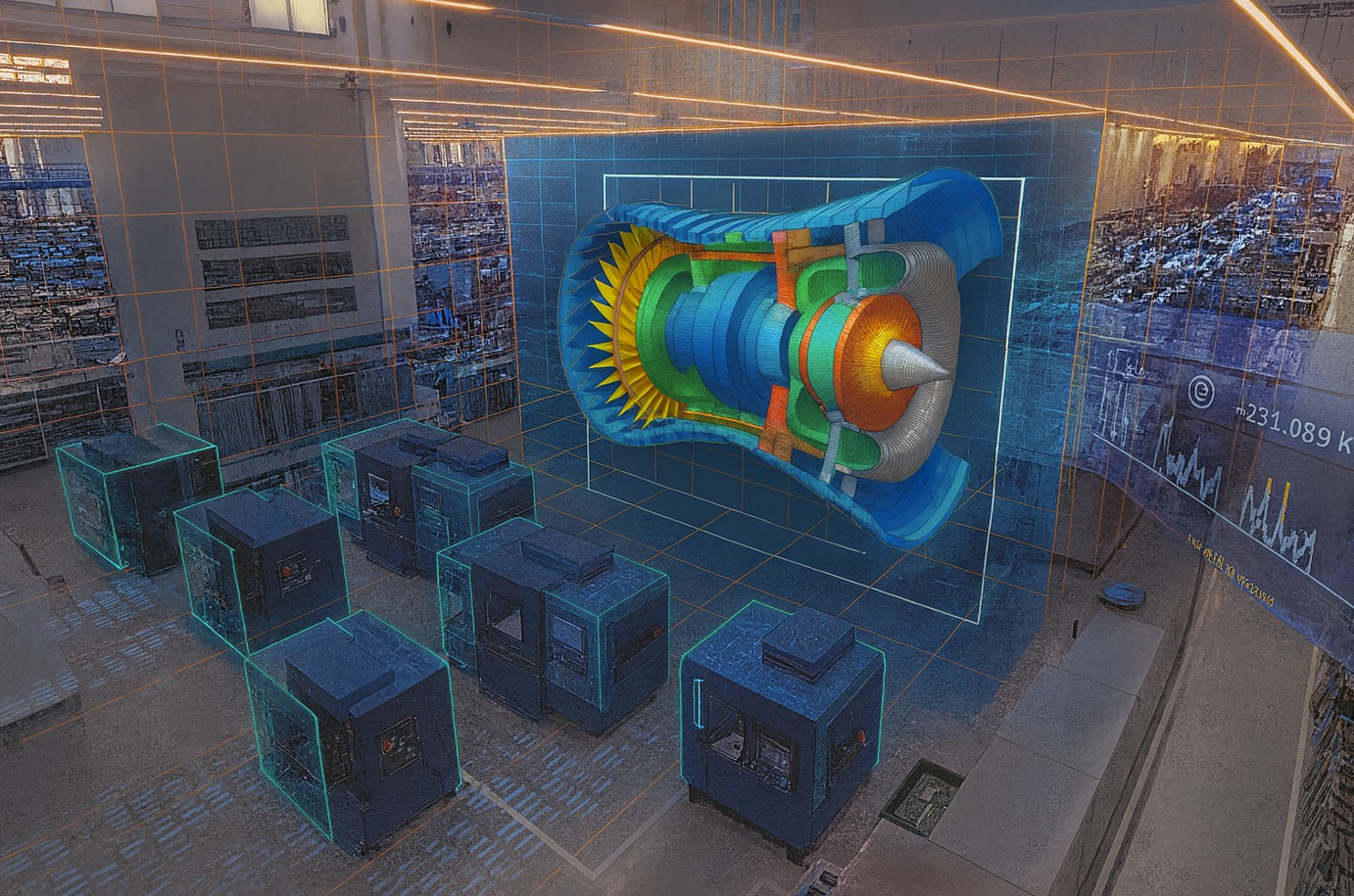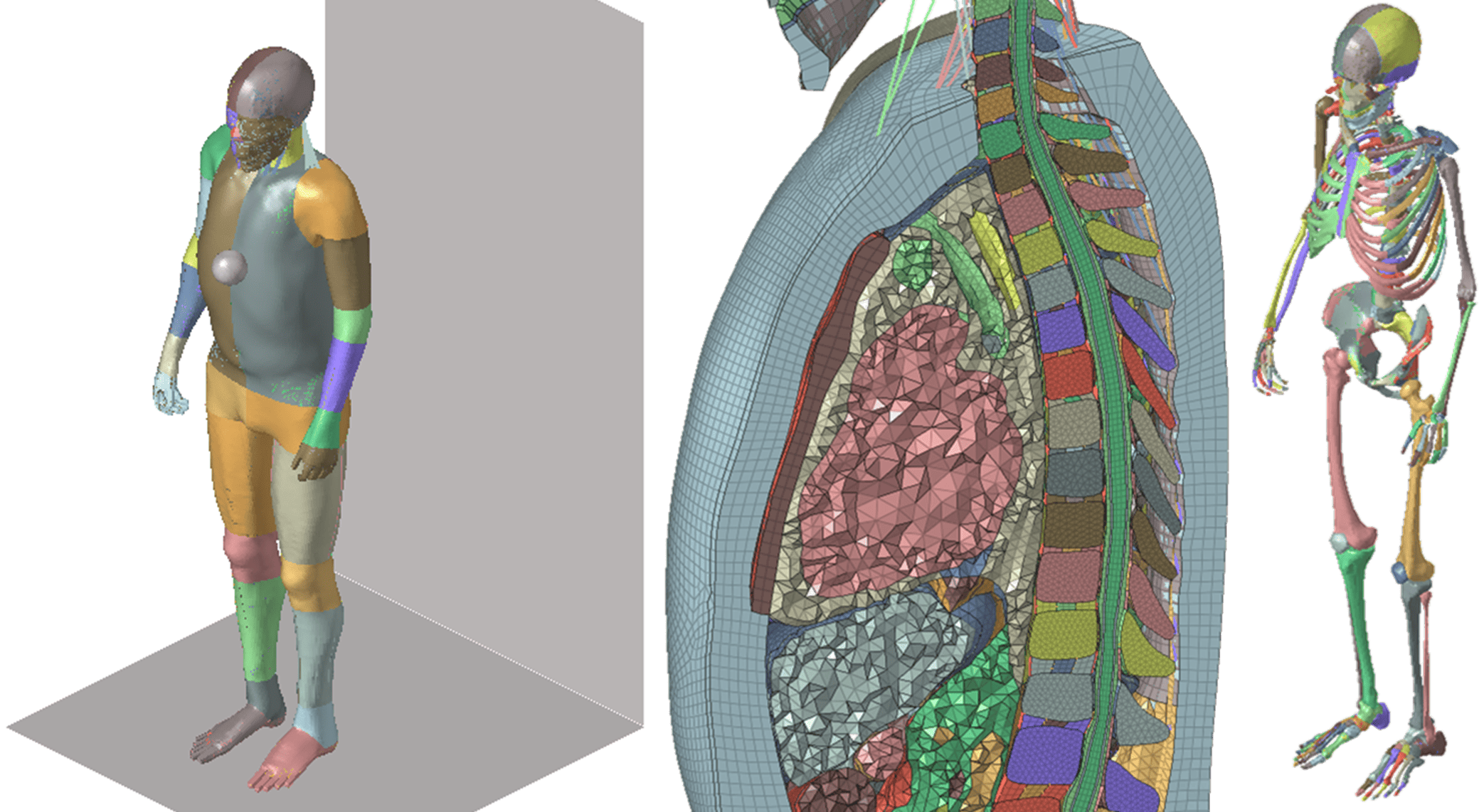Case-Study: Modular Robotic Gripper Analysis

The Challenge
Robotic Grippers Need Modularity
In automotive body-in-white production, robotic grippers are still predominantly built as welded steel frames. These structures are extremely heavy, consume high amounts of energy during operation, and lack flexibility. Any change in the production sequence, car body design, or gripping points requires lengthy and costly rework. Our customer set out to develop a modular solution – a system of building blocks that can be rearranged like LEGO to adapt quickly to new requirements. However, the company was uncertain which design variant would provide the best balance of performance, weight, and cost. To resolve this, an in-depth evaluation using Finite Element Analysis (FEA) and Simulation was initiated.
The Analysis
FE-Analysis and Comparision of Options
The customer commissioned us to investigate several design alternatives. We imported the CAD models, prepared the meshes, and carried out a series of Finite Element Analysis (FEA) studies to assess compression stiffness, bending stiffness, and torsional stiffness. To ensure a fair comparison, all models were normalized by weight so that specific stiffness values could be derived. Both individual modules and full gripper assemblies were simulated to reflect real body-in-white application scenarios. This systematic approach allowed us to compare not only the mechanical behavior of each concept but also its suitability in a modular system architecture.
The Conclusion
You cannot beat hybrid designs and engineering
The results showed that 3D-printed integral modules, with seamless structure and absence of joining seams, exhibited the lowest compliance. Yet, they were more expensive than injection-molded alternatives. To overcome this contradiction between cost and performance, we carried out parameter studies on the injection-molded design. By combining short-fiber-reinforced thermoplastic with local continuous glass fiber reinforcements, an optimized solution was identified. This hybrid concept achieved a strong cost-to-performance ratio, fulfilling the customer’s requirements while maintaining the flexibility and modularity needed for future production adjustments. Through targeted FEA and Simulation, the customer gained clarity on the most effective design path forward.
A Quick Overview of Stiffness & Strain Analysis
Structural rigidity and elastic deformation analysis is a core part of structural simulation, used to assess how components deflect and strain under applied loads. By modeling displacements and elastic responses, engineers can ensure that designs maintain the required dimensional stability in service. This type of evaluation is vital in industries where precision, comfort, or safety depends on keeping deformations within strict limits.
Typical Goals and Targets in Stiffness and Strain Simulation
The main objective of stiffness and strain analysis is to confirm that designs maintain adequate rigidity and do not experience excessive deformation during operation. Engineers use this simulation to optimize load paths, improve structural efficiency, and ensure that moving or precision-aligned components maintain their required positioning under load. The analysis also identifies high-strain regions that could indicate potential fatigue issues or the need for material reinforcement. By integrating stiffness checks early in the design process, companies can reduce costly redesigns and improve product reliability.
Core Modeling Dimensions in Structural FEA
Many structural deflection studies are performed using linear models, assuming small displacements and constant material properties. In applications where deformations are large or where materials exhibit nonlinear elasticity, a nonlinear approach ensures more realistic predictions. Choosing the right formulation impacts both accuracy and computational efficiency.
Most structural compliance evaluations are conducted as static analyses, focusing on deformation under steady-state loading. However, transient deflection studies are required when loads vary significantly over time, such as in moving machinery or rolling loads on bridges. Selecting the appropriate time model ensures the results reflect actual service conditions.
For rigidity and displacement analysis, implicit solvers are typically preferred due to their stability with static and slow-changing loads. Explicit solvers are used in high-speed deformation events, such as when stiffness is being assessed as part of an impact or drop scenario. Solver choice influences run time and the ability to handle complex contact conditions.
Accurate elastic deformation modeling requires correct material properties. Metals are often modeled as isotropic and linear elastic, while composites and plastics may require orthotropic or nonlinear elastic definitions. In lightweight structures, directional stiffness must be precisely captured to prevent unforeseen compliance issues.
Engineers can model thin-walled parts with shell elements, bulky parts with solid elements, and slender structures with beams or frames. Selecting the right element type for deflection analysis balances computational cost and solution fidelity. Hybrid modeling can combine these element types for more efficient analysis.
In certain applications, stiffness is influenced by thermal, fluid, or electromagnetic effects. For example, thermal expansion can reduce effective rigidity, or internal fluid pressure can increase local deflection. Coupled analyses improve prediction accuracy in multiphysics scenarios.
While most deflection analyses use fixed load and material inputs, probabilistic simulations account for variations in modulus, assembly tolerances, and load magnitudes. This method supports reliability engineering and ensures the design remains within acceptable deformation limits under uncertainty.
3D models are standard for detailed displacement analysis, but 2D simplifications such as plane stress or plane strain can be effective for prismatic or symmetric parts. One-dimensional beam or frame models are valuable in early-stage stiffness studies for large frameworks.
Although rigidity studies are generally static, frequency-domain methods are used when deformation is linked to vibration behavior. Modal analysis can reveal dynamic stiffness properties and help avoid resonances.
Automated parametric studies allow quick evaluation of design variants to improve stiffness-to-weight ratios. Optimization techniques help identify geometry changes that yield maximum rigidity without unnecessary material use.
Small to medium deflection problems may benefit from direct solvers for accuracy, while large, sparse systems are handled more efficiently with iterative solvers. Understanding solver strengths avoids wasted computational effort.
Most elastic deformation simulations rely on continuum models, but discrete spring or connector elements can be used when global compliance is dominated by joint flexibility. Hybrid models combine continuum and discrete approaches where appropriate.
Typical Mistakes in Structural Compliance Evaluation and How to Avoid Them
Common pitfalls include unrealistic boundary conditions, insufficient mesh refinement in high-strain regions, and neglecting load paths through connections. Failing to account for assembly preloads or environmental effects can also skew results. Preventing these mistakes requires matching constraints to real-world conditions, performing mesh convergence checks, and validating simulations against reference calculations or test data.
Exemplary Use Cases for Stiffness/Rigidity Simulation
Precision Machinery Alignment Control
Elastic deformation evaluation ensures that machine tool structures and precision equipment frames maintain micron-level alignment under operational loads, preventing product defects.
Civil Engineering Deflection Checks
Bridges, towers, and building frames undergo structural compliance analysis to maintain serviceability under live loads like traffic and wind, ensuring occupant comfort and safety.
Lightweight Vehicle Frame Optimization
In automotive design, engineers balance torsional stiffness with weight reduction to improve handling and efficiency. Rigidity analysis verifies performance before physical prototyping.
Learn more about our portfolio of Structural Engineering Services
FAQ – Elastic Deformation and Rigidity Analysis
Learn more about how we utilize advanced FE-based methods to answer your questionsabout structural elasticity.
Elastic deformation analysis is the process of predicting how much a structure will deflect and strain when subjected to specific loads, without causing permanent deformation. This type of simulation focuses on the recoverable, or elastic, behavior of materials. It helps engineers verify whether a design will maintain its intended geometry and function during normal operation, which is essential for safety and performance.
Rigidity assessment ensures that a structure or component retains its shape and alignment under operational loads, which is critical in high-precision or load-bearing applications. Even small deflections can lead to misalignment, vibration issues, or reduced service life in mechanical systems. By quantifying stiffness early in the design process, engineers can make targeted design changes before costly manufacturing or testing begins.
Structural compliance, the inverse of stiffness, is evaluated using finite element modeling to simulate the displacement of a part under applied loads. Engineers apply constraints and loads to the model and calculate the resulting displacements and strains. The results indicate whether the structure meets deflection criteria and highlight areas where reinforcement may be required.
Rigidity analysis focuses on how much a part deflects under load, while strength analysis examines whether it can withstand those loads without failing. A structure can be strong enough not to break but still too flexible for its intended function. Both evaluations are important, but stiffness issues are often linked to performance problems rather than outright failure.
Yes, elastic deformation analysis can highlight high-strain regions where cyclic loading may cause material fatigue over time. While it does not directly predict fatigue life, it identifies the locations that should be studied in more detail with dedicated fatigue simulations. This helps designers reinforce critical areas or adjust geometry to improve durability.
The accuracy of stiffness predictions depends heavily on having the correct material properties in the simulation, especially Young’s modulus and Poisson’s ratio. Using incorrect values can lead to significant differences between predicted and actual deflection. For advanced materials like composites or polymers, anisotropic and nonlinear properties must also be accurately defined.
Mesh density and element quality directly influence the accuracy of displacement and strain results. A coarse mesh might miss localized deformations, giving a false impression of higher stiffness. Performing mesh convergence studies ensures that further refinement does not significantly change the predicted results.
Temperature changes can significantly alter a material’s modulus of elasticity, which directly affects structural rigidity. In some cases, thermal expansion or contraction can introduce additional strains or reduce stiffness. Engineers often perform coupled thermo-mechanical simulations to capture these effects accurately, especially in aerospace, automotive, and electronics applications.
Experienced engineers validate simulations by comparing them with analytical hand calculations, benchmark tests, and historical project data. They often run simplified models in parallel to check whether the complex simulation is producing reasonable trends. Correlating simulation results with physical measurements builds confidence in the accuracy of the analysis.
FiniteNow.com offers a unique combination of instant online quoting, access to a scalable network of expert FEA engineers, and cost efficiency through pre-audited simulation partners. This ensures clients get both speed and high-quality technical work without compromising on budget. The platform’s streamlined process allows projects to start within hours rather than weeks.
Nonlinear deflections, such as those from large displacements or contact interactions, require incremental loading and specialized solver settings. Engineers may use arc-length methods or automatic step control to ensure convergence in challenging scenarios. These techniques capture the true structural response in conditions where linear assumptions would underestimate deformation.
For anisotropic materials, stiffness evaluation involves defining orthotropic elastic constants for different material directions. Engineers validate these models with physical tests like tensile, shear, and bending in multiple orientations. This ensures that the simulation correctly predicts directional rigidity, which is critical in applications like aerospace and high-performance automotive components.
Start Now! It will only take 12 minutes
It has never been faster, easier and more cost effective to get a quotation for your structural simulation needs:





